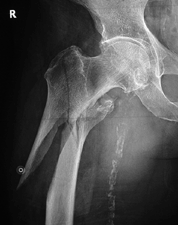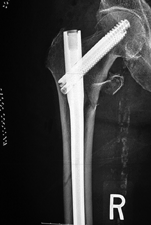Sliding hip screws validated for use in treating stable peritrochanteric hip fractures
Sliding hip screws may become the preferred device for stable peritrochanteric hip fractures based on recent evidence that they provide predictable healing at a lower cost and with a shorter operating time than intramedullary nails.
Researchers at Boston University recently evaluated the use of a protocol in which two orthopedic traumatologists used sliding hip screws for stable peritrochanteric fractures and intramedullary (IM) nails for unstable peritrochanteric fractures during a 5-year period.
“If cephallomedullary nail fixation were used only for unstable (peritrochanteric) fractures, the estimated use would be between 14.5% and 26.9%,” T. William Axelrad, MD, a trauma fellow in the department of orthopedics at Hospital for Special Surgery, said during a presentation at the 2010 Annual Meeting of the Orthopaedic Trauma Association (OTA). “However, the use of these devices is increasing and is substantially higher than the percentage of unstable fractures in the United States … Why is this important? Cephallomedullary nails are on average three times more costly than extramedullary devices such as the sliding hip screw and when used for stable fracture patterns likely provide no added benefit.”
Axelrad and colleagues analyzed operative data, radiographic union and complications for 192 patients through a retrospective review. Seventy-one of these patients were excluded due to inadequate follow-up. Of the remaining 121 patients, 62 were men; 62 patients were deemed to have stable fractures and 59 unstable fractures according to the Evans and OTA classification. Patients were an average age of 63 years, and 45% of them sustained their injuries from high-energy mechanisms, Axelrad said.
|
|
|
|
An intertrochanteric fracture with subtrochanteric extension (left) was treated with a cephalomedullary device (right). The patient healed uneventfully. Images: Axelrad TW |
|
Patients reclassified
After reclassifying patients based on a review of the injury films, 59 patients with stable fractures received a sliding hip screw and three received an IM nail. Of patients with unstable fractures, 55 received an IM nail and four received a plate. “In general, the reassessment of the fractures was consistent with the adopted protocol, with most patients with stable fractures receiving a sliding hip screw and those patients with unstable fractures being treated with a cephallomedullary nail,” Axelrad said.
The researchers reported an average operating time of 86 minutes for the sliding hip screw and 115 minutes for IM devices. Forty-two percent of the patients who received hip screws and 39% who received IM nails underwent blood transfusions.
Average tip apex distance was 16 mm for the sliding hip screw group and 22 mm for the IM nail group. Sliding hip screws also demonstrated fewer occurrences of greater than 25 mm tip apex distance.
Shortening at union
At union, shortening was 5.9 mm for the sliding hip screws and 5.3 mm for the intramedullary nails — a finding that validates the preoperative assessment of fracture stability, according to the researchers. Neck-shaft angle was an average of 135· with the hip screws and 126· with the IM nails; neither group showed a loss of this relationship with time.
Axelrad reported two screw cutouts in the plate group, one of which was a derotational screw only, and three nonunions among patients receiving intramedullary nails.
“We have shown that fractures can be reliably classified as stable or unstable such that a stability based protocol resulted in predictable healing,” Axelrad said. “The use of the sliding hip screw also resulted in significant savings to the hospital … with a total savings of [more than] $100,000 during the course of this study.” – by Tina DiMarcantonio
Reference:
- Tornetta P III, Axelrad TW, Dehaan A, et al. The orthopedic traumatologist and the peritrochanteric hip fracture: Does experience matter? Paper 041. Presented at the 2010 Annual Meeting of the Orthopaedic Trauma Association. Oct. 13-16, 2010. Baltimore.
- T. William Axelrad, MD, can be reached at the Department of Orthopedics, Hospital for Special Surgery, 534 East 70th Street New York, NY 10021; 212-606-1000; e-mail: axelradt@hss.edu.
![]() Follow
OrthoSuperSite.com on Twitter
Follow
OrthoSuperSite.com on Twitter


